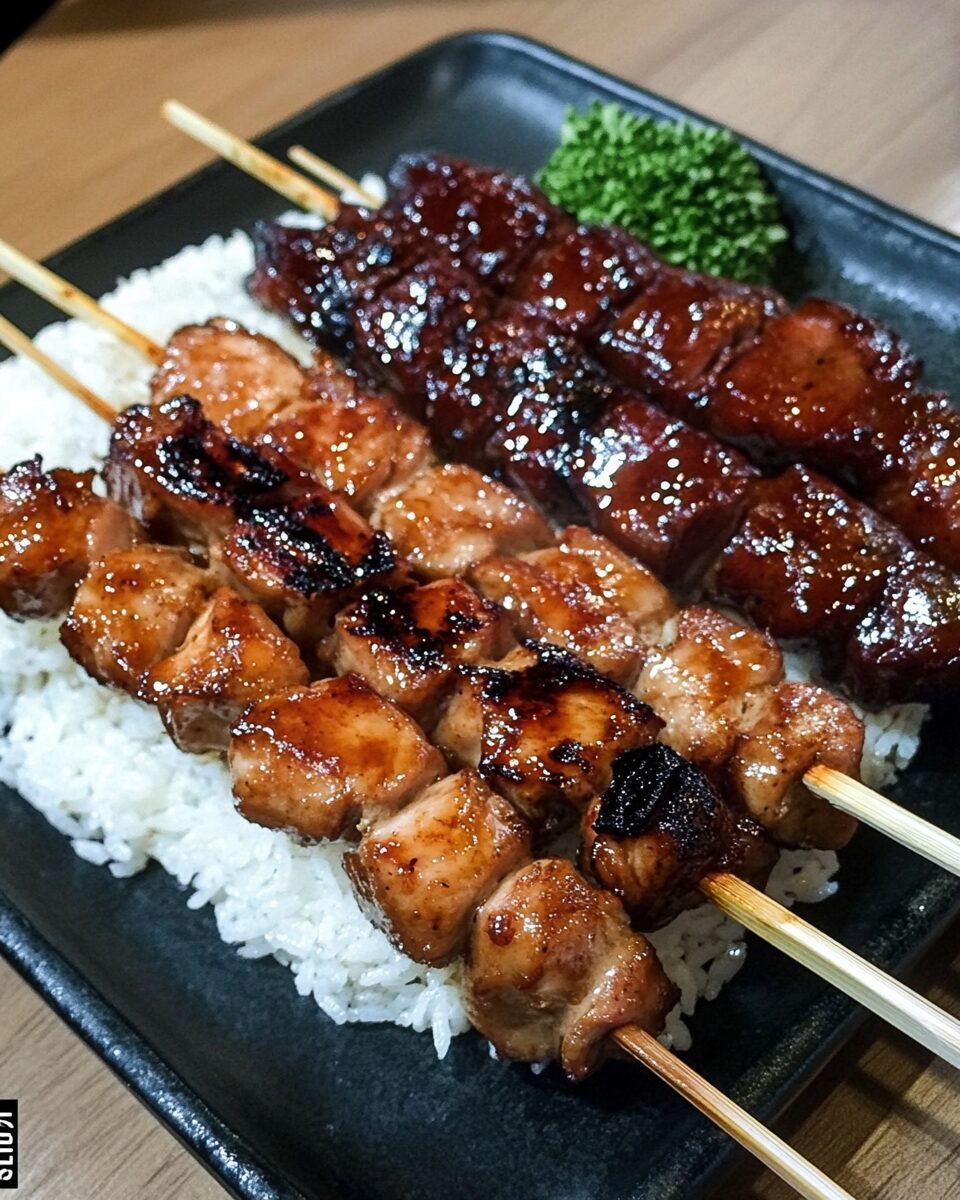A classic Japanese street food, Chicken Yakitori features tender, bite-sized chicken pieces skewered and grilled to perfection, glazed with a sweet-savory sauce. This simple yet flavorful dish is ideal as an appetizer or main course and can be easily recreated at home with minimal ingredients.
FULL RECIPE
Ingredients
- 500g boneless chicken thighs, cut into bite-sized pieces
- 1/2 cup soy sauce
- 1/4 cup mirin (sweet rice wine)
- 1/4 cup sake
- 2 tablespoons sugar
- 1 clove garlic, minced
- 1 teaspoon grated ginger
- Bamboo skewers, soaked in water for 30 minutes
- Spring onions or leeks, cut into 1-inch pieces (optional)
Directions
- In a saucepan, combine soy sauce, mirin, sake, sugar, garlic, and ginger.
- Bring to a boil over medium heat, then simmer for 10-12 minutes until slightly thickened. Set aside to cool.
- Thread chicken pieces onto soaked skewers, alternating with spring onion if using.
- Preheat grill or grill pan to medium-high heat.
- Lightly oil the grill and cook skewers for about 3-4 minutes per side.
- Brush skewers with the yakitori sauce and continue grilling until caramelized and cooked through.
- Brush with additional sauce just before serving for extra flavor.
Nutritional Information
- Calories: 250 per serving
- Protein: 22g
- Fat: 12g
- Carbohydrates: 12g
- Sugar: 8g
- Sodium: 700mg
Origin and Cultural Significance
Yakitori, meaning “grilled bird,” is a traditional Japanese dish with a rich cultural history. It originated centuries ago and gained significant popularity during the Edo period. Initially sold by street vendors, it became a common snack in izakayas, or Japanese pubs, and is now a cherished part of Japan’s food culture. Its simplicity and comforting nature make it a dish that’s perfect for social gatherings, symbolizing the shared enjoyment of food and drink.
Different Types of Yakitori
While “yakitori” typically refers to chicken skewers, the dish actually includes a variety of chicken parts. These may include tender cuts like thighs and breasts, as well as organs such as liver (reba) and heart (hatsu). Skewers often alternate between chicken and vegetables, like green onions (negima), which adds both flavor and color. This variety ensures that there’s a yakitori for every preference, whether you prefer dark meat, leaner cuts, or a mix of flavors.
Yakitori Sauce (Tare)
The key to yakitori’s distinctive taste is the tare sauce, a rich, sweet, and savory glaze. Made from soy sauce, mirin, sake, and sugar, tare is simmered until it thickens into a glossy consistency. Some versions include garlic, ginger, or dashi for added depth of flavor. This sauce is brushed on during grilling, creating a beautiful caramelized coating on the chicken.
Alternative Seasoning: Salt (Shio)
Another classic way to prepare yakitori is simply seasoning the skewers with salt, or “shio” yakitori. This version allows the chicken’s natural flavor to shine through, offering a lighter, cleaner taste. Many purists prefer this method as it highlights the smoky grilled aroma and the tender texture of the meat without the added sweetness of tare.
Grilling Technique and Tools
Traditional yakitori is grilled over binchotan charcoal, known for its clean burn and ability to impart a subtle smoky flavor. In home kitchens, gas grills, grill pans, or even broilers can be used as alternatives. The key to perfect yakitori is maintaining an even temperature and turning the skewers regularly while basting with tare to ensure a caramelized, tender result.
Importance of Skewering
Skewering is essential for both practical and aesthetic reasons. It allows the chicken to cook evenly and ensures easy handling. By threading pieces of chicken and vegetables onto the skewers, you control the grilling process and create a visually appealing dish. The presentation is important too, as the skewers are often served directly from the grill to the plate, offering a rustic, charming look.
Chicken Thighs vs. Chicken Breast
Though both chicken thighs and breasts are common choices for yakitori, thighs are the preferred option. They are juicier and more flavorful due to their higher fat content. Breast meat, while leaner, can become dry if overcooked. Skin-on, boneless thighs are ideal for grilling, as they retain moisture while developing a rich, crispy texture on the outside.
Vegetarian Yakitori Options
While yakitori traditionally uses chicken, it can easily be adapted for vegetarians. Mushroom skewers, tofu, and eggplant are popular alternatives. These vegetarian versions can be brushed with tare or seasoned with salt, just like the traditional recipe, and grilled to perfection for a smoky, umami-filled experience.
Pairing with Japanese Drinks
In Japan, yakitori is often enjoyed with drinks such as cold beer, sake, or shochu. The salty, savory flavors of the skewers complement the refreshing bitterness of beer or the smoothness of sake. This pairing creates a perfect harmony of flavors, making yakitori a favorite dish for casual dining and social occasions.
Serving Suggestions
Yakitori is versatile and can be served in a variety of ways. It can be the centerpiece of a meal, served alongside steamed rice and miso soup, or as an appetizer in a larger meal. For parties, it makes an excellent finger food that can be enjoyed with friends and family, adding a fun and interactive element to the dining experience.
Health Benefits and Nutritional Value
Yakitori provides a good source of protein, especially when using chicken thighs, which also offer healthy fats. While the tare sauce adds sugar and sodium, portion control makes it a relatively healthy option. When served with grilled vegetables or rice, yakitori becomes a balanced meal that is filling yet not overly indulgent.
Marinating vs. Basting
Some yakitori recipes call for marinating the chicken in tare before grilling, while others focus on basting the skewers with sauce as they cook. Marinating helps tenderize the meat and infuse it with flavor, while basting creates a glossy finish and adds layers of sweetness and umami during grilling. Both methods result in delicious skewers, but basting is more common for achieving that signature caramelized coating.
Storage and Reheating
Leftover yakitori can be stored in the refrigerator for up to three days. To reheat, it’s best to use an oven or skillet to preserve the texture. Microwaving may cause the exterior to lose its crispness, but it’s still a convenient option if you’re in a hurry. Regardless of how you reheat, yakitori remains tasty even the next day.
Street Food Culture in Japan
Yakitori is an iconic street food in Japan, often found in bustling night markets and food stalls near train stations. It represents casual, outdoor dining and brings people together in a social, lively atmosphere. In these settings, yakitori is more than just food—it’s a way to connect with others and experience a part of Japanese culture.
Regional Variations
Different regions in Japan put their own spin on yakitori. For example, in Fukuoka, yakitori might include pork belly, and in Hokkaido, seafood like squid or scallops might be grilled in the same style. These regional variations highlight the flexibility of the dish and demonstrate how different ingredients and local flavors shape yakitori across Japan.
Yakitori in Modern Cuisine
Yakitori has evolved and made its way into modern cuisine worldwide. Chefs outside Japan have put their own creative twist on the dish, using unique ingredients like chili flakes, sesame oil, or miso in the tare. These modern variations keep the traditional techniques alive while adding exciting new flavors that appeal to diverse palates.
Making It Kid-Friendly
Yakitori is easily adaptable for children, who often enjoy the interactive nature of skewers. Smaller, milder skewers with less salt or a sweeter tare can be created to suit young tastes. Serving yakitori alongside rice and a dipping sauce helps balance the flavors, making it an enjoyable meal for all ages.
Tips for Hosting a Yakitori Party
Hosting a yakitori party can be a fun and memorable experience. Prepare a variety of skewers in advance, offer both tare and shio options, and set up a grill or skewers over a portable grill. This allows guests to cook their own skewers, adding an interactive element to the meal. Make sure to have plenty of sides, dipping sauces, and drinks to complement the skewers.
Sustainability and Sourcing
Using every part of the chicken in yakitori aligns with sustainable cooking practices. This not only reduces waste but also honors the animal by utilizing all its parts. Additionally, choosing organic, free-range chicken ensures a higher quality product, while sourcing local vegetables supports sustainable agriculture.
Conclusion
Chicken yakitori is a simple yet flavorful dish that has become an enduring symbol of Japanese street food culture. It represents the perfect balance of smoky, sweet, and savory flavors, and its versatility makes it adaptable for various dietary preferences and occasions. Whether enjoyed in an izakaya or grilled at home, yakitori continues to bring people together, offering a unique and delicious dining experience that spans cultures and generations.






